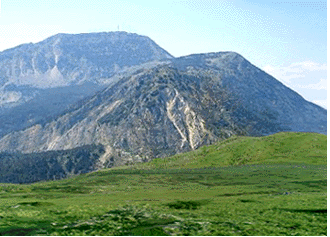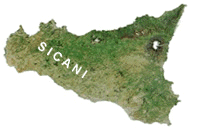...Best of Sicily presents... Best of Sicily Magazine. ... Dedicated to Sicilian art, culture, history, people, places and all things Sicilian. |
by Vincenzo Mormino | |||
Magazine Index Best of Sicily Arts & Culture Fashion Food & Wine History & Society About Us Travel Faqs Contact Map of Sicily
|
These mountains of myth deserve better, identified as they are with the tale of Icarus and Daedalus. Located in an area bordered by Ficuzza in the north, Caltanissetta in the east, Salemi in the west and Agrigento to the south, they are linked to the ancient Sikanians. This, of course, was not the only part of Sicily ever inhabited by the Sicanians. It's just that by the time the Phoenicians and Greeks arrived these Sicilian natives were confined to a relatively small region of west-central Sicily. The highest mountains of the Sicanian chain are Rocca di Bussambra (overlooking Ficuzza) at approximately 1613 metres and, to its southeast, Mount Cammarata at 1578 metres. The latter appears slightly higher, owing perhaps to the valleys around it, but both receive a fine dusting of snow that sometimes lasts for as long as a few weeks during February. Popular with campers and picnickers, the forests around these two peaks, with their ashes, stone pines and oaks, are the largest in the Sicanian Mountains, making for scenic excursions. A number of streams flow through the Sicanians, but the most historic is the Platani (named for the plane trees that grew along its banks), which the ancient Greeks called the Halykos. It was navigable back then, and didn't dry out in the hot summer months. For some time it marked the border between Greek and Carthaginian territory. Except at the highest altitudes and in a few protected areas, there aren't many forests in the Sicanian Mountains. In the
nineteenth century Most of the region was turned over to agriculture long ago. When the Romans recognised Sicily as the breadbasket (or granary) of their expanding empire, it was the Sicanian Mountains that they were talking about. During the Greek period, however, it was still heavily wooded. The deforestation took place rapidly, perhaps in the space of a few decades. Many of the towns in the Sicanian region were founded or re-populated by Arabs and Berbers during Sicily's Arab period. The ports of Agrigento and Sciacca were easily reached from Tunisia, which can be seen from some of the high hills along the coast on a clear day. Around the time of the Sicilian Vespers (1282), the Sicanian Mountains began to be subjected to some of Europe's worse feudalism. There was no serfdom per se, but the families that purchased feudal property exploited the towns terribly. After five centuries, the sulfur industry, which forced young boys into service in the mines as virtual slaves, became the cruelest expression of this. By the eighteenth century, most the area's more important aristocrats were spending more time in Palermo than on their farms. It is widely believed that the Mafia originated in this part of Sicily, not as a response to feudal oppression but because the wealthy absentee landlords left day-to-day administration of their vast estates to hated gabelloti, infamously harsh and corrupt overseers inclined toward greed, banditry, theft and murder. Until 1812 the purchaser of property designated "feudal" could claim the title that went with that piece of land, and in this way a number of gabelloti became barons in the two decades immediately before 1812. Nowhere else in Sicily were these upstarts despised so much as in the Sicanian Mountains. The overpopulated towns of the Sicani experienced a particularly high level of emigration between 1890 and 1925. Even today, Agrigento and Caltanissetta are usually reported as the two poorest provinces in Italy, sometimes joined by neighbouring Enna. But the region is not without its charm and its traditions. The Agrigento goat is one of the characteristic livestock breeds of the region. There are hedgehogs in the region, and a few exemplars of Hermann's tortoise, especially around the man-made lakes. The native deer are long extinct, but a programme is underway to reintroduce them in a few nature reserves. About the Author: Vincenzo Mormino has written about wildlife and nature for Best of Sicily and hard-copy publications. | ||
Top of Page |
 It could be said, perhaps
uncharitably, that in Sicily certain mountains, and mountain ranges, are more spectacular than
others.
It could be said, perhaps
uncharitably, that in Sicily certain mountains, and mountain ranges, are more spectacular than
others.  this
was one of Sicily's chief
this
was one of Sicily's chief